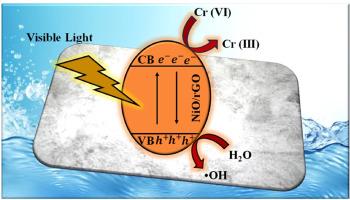Visible light active transition metal chalcogenide/rGO nanocomposite photocatalyst for photoreduction of chromium (IV)
IF 3.4
4区 化学
Q2 CHEMISTRY, MULTIDISCIPLINARY
引用次数: 0
Abstract
A hydrothermal technique was utilized to produce NiO/rGO nanocomposite, with the objective of boosting photocatalytic reduction of hexavalent chromium (Cr (VI)) to trivalent chromium (Cr (III)). A diversity of analytical methods was used to evaluate optical, structural and textural attributes of substances. The findings indicated that the addition of rGO to NiO led to decline in band gap (B.G), with values of 3.38 and 2.91 eV for NiO and NiO/rGO, respectively. The NiO/rGO nanocomposite displayed a superior photoreduction efficiency of 96.2 %, compared to NiO (78.7 %), after a duration of 90 min. Increasing specific surface area (SSA) of nanomaterials enhances proportion of the substance interacting with Cr ions, hence improving photocatalytic activity. A substantial interfacial area and pore size facilitate the generation of photo-induced electrons (e−) along with hole (h+) pairs. The results demonstrate that NiO/rGO nanocomposite serves as an effective catalyst for Cr (VI) photoreduction. The nanocomposite material may serve as a promising catalyst in various upcoming studies related to photocatalysis.

可见光活性过渡金属硫族化物/氧化石墨烯纳米复合光催化剂光还原铬(IV)
利用水热技术制备NiO/rGO纳米复合材料,目的是促进六价铬(Cr (VI))光催化还原为三价铬(Cr (III))。多种分析方法被用来评价物质的光学、结构和纹理属性。结果表明:NiO中加入rGO后,NiO和NiO/rGO的带隙B.G值分别为3.38 eV和2.91 eV。NiO/rGO纳米复合材料在90 min后的光还原效率为96.2%,而NiO的光还原效率为78.7%。增加纳米材料的比表面积(SSA)可以提高材料与Cr离子相互作用的比例,从而提高光催化活性。较大的界面面积和孔径有利于光诱导电子(e−)和空穴(h+)对的产生。结果表明,NiO/rGO纳米复合材料可作为Cr (VI)光还原的有效催化剂。该纳米复合材料在今后的光催化研究中具有广阔的应用前景。
本文章由计算机程序翻译,如有差异,请以英文原文为准。
求助全文
约1分钟内获得全文
求助全文
来源期刊
CiteScore
3.50
自引率
7.70%
发文量
492
审稿时长
3-8 weeks
期刊介绍:
The Journal of the Indian Chemical Society publishes original, fundamental, theorical, experimental research work of highest quality in all areas of chemistry, biochemistry, medicinal chemistry, electrochemistry, agrochemistry, chemical engineering and technology, food chemistry, environmental chemistry, etc.

 求助内容:
求助内容: 应助结果提醒方式:
应助结果提醒方式:


